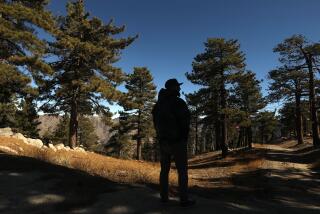Old Map Sparks a Modern Quandary
A skirmish over coastal development west of Santa Barbara hinges on a 118-year-old township map filed by a land speculator who looked at the rugged Gaviota coast and saw Italy.
John Williamsâ vision of a Naples-in-California tourist destination faded long ago, doomed by a lack of investors and promised rail lines.
But the coastal bluffs he bought in 1887 and subdivided as Naples Townsite the next year have become the focus of a long battle.
An Orange County developer plans to build mansions on the bluffs. On Thursday, more than 200 Santa Barbara activists packed a stuffy hearing chamber to protest the plan.
Picking through a 1,300-page environmental study, opponents derided the proposed luxury development as unsuitable for the rural area and a catalyst for growth that would forever change the scenic bluffs.
âThis world-class coast should not be destroyed by this mega-project,â said Keith Zandona, president of the Santa Barbara Archaeological Society. âThe land has spirits, and they are here tonight.â
All sides agree that there would be no fight were it not for that lot division map filed by Williams on July 23, 1888.
It identified 400 lots on which houses could be built and was all but forgotten until the early 1980s, when landowners tried to assert those rights.
When the county attempted to impose modern zoning restrictions on the property, limiting development to one home per 100 acres, earlier landowners fought back in court.
In 1994, the state Supreme Court sided with the landowners, declaring that Williamsâ township map was valid. But the county adopted the official map of Naples in 1995, recognizing only 274 legal parcels.
Opponents acknowledge that developer Matt Osgood has the right to build hundreds of homes on the 485-acre chunk of Naples covered by Williamsâ map. Osgood entered the picture when he bought the land in 1997.
But they are demanding that the county abide by a coastal policy that allows officials to transfer Osgoodâs development rights to more urban areas in nearby Goleta and Santa Barbara. If that fails, opponents say, Osgood should at least be forced to keep the estate-sized homes away from bluff-top vistas.
The countyâs Planning Department is looking at two development proposals from Osgood calling for 54 to 72 mansions along both sides of U.S. 101 about two miles west of Goleta.
This weekâs hearing to collect public comments on the environmental study is one of at least a dozen that must take place before the so-called Santa Barbara Ranch project goes before the Santa Barbara County Planning Commission.
The project must also gain approval from county supervisors and the California Coastal Commission, a process that could take months or even years.
At stake, activists say, is a scenic view that motorists have enjoyed for generations, as well as a place where locals hike, watch birds and just contemplate the day. They fear Osgoodâs project could trigger Malibu-like development of the coastline from Goleta north to Lompoc.
âThis will very much set the tone for whatâs going to happen on the Gaviota coast,â said Marc Chytilo, an environmental lawyer.
Osgood counters that both proposals call for far fewer homes than the number legally allowed.
Osgood wants to build 16 to 22 estates south of U.S. 101 in the coastal bluffs area that activists have said is their greatest concern. He is legally entitled to build up to 157 homes there, said Jim Youngson, a spokesman for the developer.
âPeople hopefully appreciate that this development, in the hands of a less conscientious developer, could result in much greater impacts than anything being proposed today,â Youngson said.
Osgoodâs initial proposal called for 54 residences with 325 acres set aside permanently for farming and open space. The residences would have ranged from 3,700 to 13,300 square feet.
Osgood later learned that the owners of the 2,769-acre Dos Pueblos Ranch immediately north of Naples were interested in selling their property.
Together, Osgood and the Dos Pueblos owners submitted an alternative proposal that calls for 72 large residences over a wider area, with 3,000 acres of protected open space and agricultural land. Both proposals include public amenities, including stairs to the beach, coastal trails and restrooms.
The alternate plan has less development in the coastal zone but includes construction of nine residences on the bluffs. Critics say this option is an improvement but that it doesnât go far enough.
They want all the residences to be built in the rolling hills north of U.S. 101, in the Dos Pueblos area, not on the bluffs.
Coastal land, including the bluffs, should remain âsacred,â said Mike Lunsford of the Naples Coalition, a consortium of local activist groups.
âWe want to see the homes go up and out of sight,â Lunsford said.
Santa Barbara County officials say they have investigated the possibility of swapping development rights to a more suitable area, perhaps in nearby Goleta or Santa Barbara.
A preliminary study suggested that such a plan would be only partly successful because of disparity in land values and other complications, said Tom Figg, the countyâs project manager.
So far, the idea has been a political hot potato. County supervisors rejected any swaps, and the Goleta City Council has shown little interest.
Only the Santa Barbara City Council has asked for more information. Despite the apparent lack of support, many opponents at Thursdayâs hearing urged the county to try again.
âBy no means are there insurmountable objections,â said Ken Palley of the Surfrider Foundation. âIt is not acceptable to stop now.â
Comments on the environmental study will be accepted until Aug. 28, said Steve Chase, the county deputy director of planning. The debate is to go before the Planning Commission in the fall and to county supervisors in early 2007, Chase said.
Osgood said he is ready for a struggle. The activists said they would be there, fighting, every step of the way.
âThis is a development for a few financially privileged people, and itâs going to affect people for generations to come,â said Robert Andre, who lives near Naples. âThe hundreds of people here are practicing stewardship of this land.â
More to Read
Sign up for Essential California
The most important California stories and recommendations in your inbox every morning.
You may occasionally receive promotional content from the Los Angeles Times.











